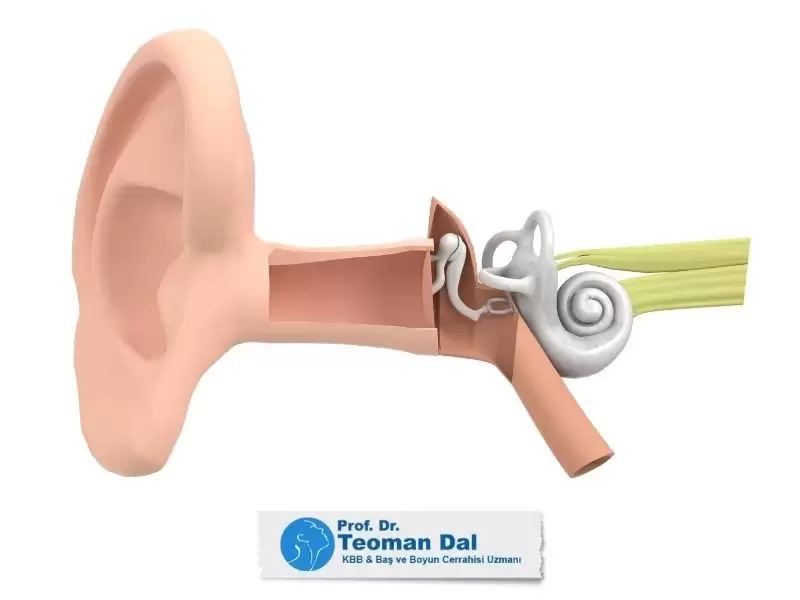Akut yani ani başlayan kulak iltihapları özellikle çocukluk döneminde sık görülen enfeksiyonlardır ve tedavi edilmediklerinde işitme kaybı, kulak zarı delinmesi, kulak arkasındaki mastoid kemiğin iltihaplanması gibi sorunlara yol açabililer.
Orta Kulak Nedir?
Orta kulak, kulak zarının arkasında yer alan ve normalde hava ile dolu olan boşluktur. Orta kulak boşluğunda hava basıncının dengelenmesi, östaki kanalının yutkunma sırasında açılmasıyla sağlanır. Bu kanal sayesinde orta kulak ile dış ortam arasındaki basınç her yutkunmada eşitlenir ve sağlıklı işitme mümkün olur.
Östaki kanalındaki fonksiyon bozuklukları, orta kulak basıncının düşmesine, enfeksiyonlara, orta kulakta sıvı birikmesine ve işitme kaybına neden olabilir. Özellikle çocuklarda bu kanal daha kısa ve düz olduğu için enfeksiyon riski daha fazladır.
Normal İşitme Süreci
Dış kulaktan gelen ses dalgaları kulak zarına çarparak titreşim oluşturur. Bu titreşimler, orta kulaktaki kemikçikler aracılığıyla iç kulağa iletilir ve burada sinirsel sinyallere dönüştürülerek beyine aktarılır. Orta kulakta oluşan enfeksiyonlar bu süreci olumsuz etkileyebilir.
Orta Kulak Enfeksiyonu Nedir?
Orta kulak iltihapları, kulak zarının arkasında yer alan boşlukta oluşan bakteriyel ya da viral kaynaklı enfeksiyonlardır. Genellikle üst solunum yolu enfeksiyonlarını takiben enfeksiyonun Östaki Kanalı yolu ile kulağa geçmesi sonucu ortaya çıkar. En sık görüldüğü gruplar şunlardır:
- 5 yaş altı çocuklar
- Erkek çocuklar
- Biberonla beslenen bebekler
- Kreş ve yuva ortamındaki çocuklar
- Sigara dumanına maruz kalan çocuklar
Orta kulak iltihapları erişkinlerde de görülebilmekle birlikte, çocuklarda daha yaygındır.
A) Seröz Orta Kulak İltihabı (Efüzyonlu Otitis Media)
Östaki kanalının enfeksiyon veya alerji gibi nedenlerle işlevini yitirmesi sonucunda orta kulakta sıvı birikir. Bu durum “seröz otit” olarak adlandırılır. En önemli belirtiler:
- İşitme kaybı
- Televizyon sesini yükseltme
- Söylenenleri anlamada zorluk
- Konuşma bozuklukları
- Okul başarısında düşüş
Seröz otit oluşmasına neden olan başlıca durumlar;
- Geniz eti büyümesi
- Burun ve sinüs enfeksiyonları
- Alerjiler
- Bağışıklık yetmezlikleri
- Nadir durumlarda östaki kanalına baskı yapan tümörlerdir.

Tanı ve Tedavi
Tanı genellikle işitme kaybı ya da geniz etine bağlı şikayetler nedeni ile yapılan muayene sırasında konur. Tedavide antibiyotik, mukus inceltici ve alerji ilaçları kullanılır. Balon şişirme veya sakız çiğneme gibi aktiviteler faydalı olabilir.
Tedaviye rağmen 6-8 hafta içinde düzelmeyen, 20-25 dB üzerinde işitme kaybı olan hastalarda cerrahi tedavi tercih edilir. Kronik seröz otit olan hastalarda kulak zarına havalandırma tüpü takılması en yaygın cerrahi tedavi şeklidir. Bu ameliyat sırasında genellikle geniz eti de alınır, hastanın durumuna göre bademciklerin alınması da cerrahiye eklenebilir.
B) Akut Orta Kulak İltihabı
Akut otitis media, östaki kanalından orta kulağa ulaşan virüs veya bakteriler nedeniyle oluşur. Bu mikroplar mukozada ödem ve iltihaba neden olurler.
Belirtiler
- Kulak ağrısı
- Yüksek ateş
- İştahsızlık
- Kulakta dolgunluk hissi
- Kulak akıntısı
- Bebeklerde kulak çekiştirme
Tanı ve Tedavi
Enfeksiyonun tanısı klinik muayene ile konur. Antibiyotik tedavisi en az 10 gün sürmelidir. Ek olarak ateş düşürücüler, ağrı kesiciler ve burun açıcılar da kullanılır.
Orta kulaktaki sıvının tamamen kaybolması 2-6 hafta sürebilir. Dirençli vakalarda cerrahi müdahale (havalandırma tüpü uygulaması) gerekebilir.





